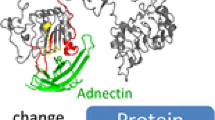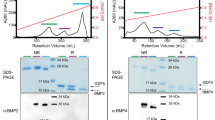Summary
Fibroblast growth factors (FGF), which have been implicated in tumor cell growth and angiogenesis, have biological activities that appear to be mediated by both heparinlike extracellular matrix sites and transmembrane tyrosine kinase receptor sites. In the present study, we demonstrated that inositolhexakisphosphate (InsP6) inhibits basic FGF (bFGF) binding to heparin. Our spectrofluorometric analyses demonstrated that InsP6 not only bound to bFGF, presumably within the bFGF heparin-binding domain, but also protected bFGF from degradation by trypsin. Also, InsP6 inhibited the cellular binding of bFGF and other fibroblast growth factor family members such as acidic FGF (aFGF) and K-FGF in a saturable and dose-dependent manner. Furthermore, concentrations as low as 100µM InsP6 inhibited bFGF-induced DNA synthesis in AKR-2B fibroblasts, as well as the growth of bFGF-and K-FGF-transfected NIH/3T3 cells. Together, these results indicate that InsP6 may serve as a useful antagonist of FGF activity.
Similar content being viewed by others
References
Baird, A.; Schubert, D.; Ling, N., et al. Receptor- and heparin-binding domains of basic fibroblast growth factor. Proc. Natl. Acad. Sci. USA 85:2324–2328; 1988.
Blam, S. B.; Mitchell, R.; Tischer, E., et al. Addition of growth hormone secretion signal to basic fibroblast growth factor results in cell transformation and secretion of aberrant forms of the protein. Oncogene 3:129–136; 1988.
Bradford, M. A rapid and sensitive method for the quantitation of microgram quantities of protein utilizing the principal of protein-dye binding. Anal. Biochem. 72:248–254; 1976.
Burgess, W. H.; Maciag, T. The heparin-binding (fibroblast) growth factor family of proteins. Annu. Rev. Biochem. 58:575–606; 1989.
Delli-Bovi, P.; Curatola, A. M.; Newman, K. M. Processing, secretion, and biological properties of a novel growth factor of the fibroblast growth factor family with oncogenic potential. Mol. Cell. Biol. 8:2933–2941; 1988.
Giordano, S.; Sherman, L.; Lyman, W., et al. Multiple molecular weight forms of basic fibroblast growth factor are developmentally regulated in the central nervous system. Dev. Biol. 152:293–303; 1992.
Gospodarowicz, D.; Cheng, J. Heparin protects basic and acidic FGF from inactivation. J. Cell Physiol. 128:475–484; 1986.
Heyduk, T.; Lee, J. C.Escherichia coli cAMP receptor protein: evidence for three protein conformational states with different promoter binding affinities. Biochemistry 28:6914–6924; 1989.
Houmard, G.; Drapeau, G. R. Staphylococcal protease: a proteolytic enzyme specific for glutamoyl bonds. Proc. Natl. Acad. Sci. USA 69:3506–3509; 1972.
Houssaint, E.; Blanquet, P. R.; Champion-Arnaud, P., et al. Related fibroblast growth factor receptor genes exist in the human genome. Proc. Natl. Acad. Sci. USA 87:8180–8184; 1990.
Johnson, D. E.; Lu, J.; Chen, H., et al. The human fibroblast growth factor receptor genes: A common structural arrangement underlies the mechanisms for generating receptor forms that differ in their third immunoglobulin domain. Mol. Cell. Biol. 11:4627–4634; 1991.
Kan, M.; DiSorbo, D.; Hou, J., et al. High and low affinity binding of heparin-binding growth factor to a 130 kDa receptor correlates with stimulation and inhibition of growth of a differentiated human hepatoma cell. J. Biol. Chem. 263:11306–11313; 1988.
Kan, M.; Shi, E. Fibronectin, not laminin, mediates heparin-dependent heparin-binding growth factor type I binding to substrata and stimulation of endothelial cell growth. In Vitro Cell. Dev. Biol. 26:1151–1156; 1990.
Kan, M.; Shi, E.; McKeehan, W. L. Identification and assay of fibroblast growth factor receptors. Methods Enzymol. 198:158–174; 1991.
Kan, M.; Wang, F.; Xu, J., et al. An essential heparin-binding domain in the fibroblast growth factor receptor kinase. Science 259:1918–1921; 1993.
Keegan, K.; Johnson, D. E.; Williams, L. T., et al. Isolation of an additional member of the fibroblast growth factor receptor family, FGFR-3. Proc. Natl. Acad. Sci. USA 88:1095–1099; 1991.
Morrison, R. S.; Giordano, S.; Yamaguchi, F., et al. Basic fibroblast growth factor expression is required for clonogenic growth of human glioma cells. J. Neurosci. Res. 34:502–509; 1993.
Moscatelli, D.; Joseph-Silverstein, J.; Manejias, R., et al. Mr 25 000 heparin-binding protein from guinea pig brain is a high molecular weight form of basic fibroblast growth factor. Proc. Natl. Acad. Sci. USA 84:5778–5782; 1987.
Partanen, J.; Makela, T. P.; Eerola, E., et al. FGFR-4, a novel acidic fibroblast growth factor receptor with a distinct expression pattern. EMBO J. 10:1347–1354; 1991.
Quarto, N.; Talarico, D.; Sommer, A., et al. Transformation by basic fibroblast growth factor requires high levels of expression: comparison with transformation byhst/K-fgf. Oncogene Res. 5:101–110; 1989.
Rapraeger, A. C.; Krufka, A.; Olwin, B. B. Requirement of heparan sulfate for bFGF-mediated fibroblast growth and myoblast differentiation. Science 252:1705–1708; 1991.
Rifkin, D. B.; Moscatelli, D. Recent developments in the cell biology of basic fibroblast growth factor. J. Cell Biol. 109:1–6; 1989.
Rogelj, S.; Weinberg, R. A.; Fanning, P., et al. Basic fibroblast growth factor fused to a signal peptide transforms cells. Nature 331:173–175; 1988.
Ruta, M.; Burgess, W.; Givol, D., et al. Receptor for acidic fibroblast growth factor is related to the tyrosine kinase encoded by the fms-like gene (FLG). Proc. Natl. Acad. Sci. USA 86:8722–8726; 1989.
Saksela, O.; Moscatelli, D.; Sommer, A., et al. Endothelial cell-derived heparan sulfate binds basic fibroblast growth factor and protects it from proteolytic degradation. J. Cell. Biol. 107:743–751; 1988.
Sasada, R.; Kurokawa, T.; Iwane, M., et al. Transformation of mouse BALB/c 3T3 cells with human basic fibroblast growth factor cDNA. Mol. Cell. Biol. 8:588–594; 1988.
Savage, C. R. Jr.; Cohen, S. Epidermal growth factor and a new derivative. J. Biol. Chem. 247:7609–7611; 1972.
Schreiber, A. B.; Kenney, J.; Kowalski, W. J., et al. Interaction of endothelial cell growth factor with heparin: characterization by receptor and antibody recognition. Proc. Natl. Acad. Sci. USA 82:6138–6142; 1985.
Sherman, L.; Stocker, K. M.; Morrison, R. S., et al. Basic fibroblast growth factor (bFGF) acts intracellularly to cause the transdifferentiation of avian neural crest-derived Schwann cell precursors into melanocytes. Development 118:1313–1326; 1993.
Shipley, G. D. A serum-free [3H] thymidine incorporation assay for the detection of transforming growth factors. J. Tiss. Cult. Methods 10:117–123; 1986.
Talarico, D.; Basilico, C. The K-fgf/hst oncogene induces transformation through an autocrine mechanism that requires extracellular stimulation of the mitogenic pathway. Mol. Cell. Biol. 11:1138–1145; 1991.
Vlodavsky, I.; Folkman, J.; Sullivan, R., et al. Endothelial cell-derived basic fibroblast growth factor: Synthesis and deposition into subendothelial extracellular matrix. Proc. Natl. Acad. Sci. USA 84:2292–2296; 1987.
Yayon, A.; Klagsbrun, M.; Esko, J. D., et al. Cell surface, heparin-like molecules are required for binding of basic fibroblast growth factor to its high affinity receptor. Cell 64:841–848; 1991.
Author information
Authors and Affiliations
Rights and permissions
About this article
Cite this article
Morrison, R.S., Shi, E., Kan, M. et al. Inositolhexakisphosphate (InsP6): An antagonist of fibroblast growth factor receptor binding and activity. In Vitro Cell Dev Biol - Animal 30, 783–789 (1994). https://doi.org/10.1007/BF02631302
Received:
Accepted:
Issue Date:
DOI: https://doi.org/10.1007/BF02631302




